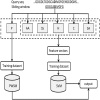Identification of metal ion binding sites based on amino acid sequences
- PMID: 28854211
- PMCID: PMC5576659
- DOI: 10.1371/journal.pone.0183756
Identification of metal ion binding sites based on amino acid sequences
Abstract
The identification of metal ion binding sites is important for protein function annotation and the design of new drug molecules. This study presents an effective method of analyzing and identifying the binding residues of metal ions based solely on sequence information. Ten metal ions were extracted from the BioLip database: Zn2+, Cu2+, Fe2+, Fe3+, Ca2+, Mg2+, Mn2+, Na+, K+ and Co2+. The analysis showed that Zn2+, Cu2+, Fe2+, Fe3+, and Co2+ were sensitive to the conservation of amino acids at binding sites, and promising results can be achieved using the Position Weight Scoring Matrix algorithm, with an accuracy of over 79.9% and a Matthews correlation coefficient of over 0.6. The binding sites of other metals can also be accurately identified using the Support Vector Machine algorithm with multifeature parameters as input. In addition, we found that Ca2+ was insensitive to hydrophobicity and hydrophilicity information and Mn2+ was insensitive to polarization charge information. An online server was constructed based on the framework of the proposed method and is freely available at http://60.31.198.140:8081/metal/HomePage/HomePage.html.
Conflict of interest statement
Figures




Similar articles
-
Development of tools and database for analysis of metal binding sites in protein.Protein Pept Lett. 2010 Jun;17(6):765-73. doi: 10.2174/092986610791190246. Protein Pept Lett. 2010. PMID: 20205657
-
Identification of Ca(2+)-binding residues of a protein from its primary sequence.Genet Mol Res. 2016 May 20;15(2). doi: 10.4238/gmr.15027618. Genet Mol Res. 2016. PMID: 27323050
-
Recognizing ion ligand binding sites by SMO algorithm.BMC Mol Cell Biol. 2019 Dec 11;20(Suppl 3):53. doi: 10.1186/s12860-019-0237-9. BMC Mol Cell Biol. 2019. PMID: 31823742 Free PMC article.
-
Computational approaches for de novo design and redesign of metal-binding sites on proteins.Biosci Rep. 2017 Mar 27;37(2):BSR20160179. doi: 10.1042/BSR20160179. Print 2017 Apr 28. Biosci Rep. 2017. PMID: 28167677 Free PMC article. Review.
-
Metal Ion Signaling in Biomedicine.Chem Rev. 2025 Jan 22;125(2):660-744. doi: 10.1021/acs.chemrev.4c00577. Epub 2025 Jan 2. Chem Rev. 2025. PMID: 39746035 Free PMC article. Review.
Cited by
-
Physicochemical and biological impact of metal-catalyzed oxidation of IgG1 monoclonal antibodies and antibody-drug conjugates via reactive oxygen species.MAbs. 2022 Jan-Dec;14(1):2122957. doi: 10.1080/19420862.2022.2122957. MAbs. 2022. PMID: 36151884 Free PMC article.
-
Amodiaquine drug pressure selects nonsynonymous mutations in pantothenate kinase 1, diacylglycerol kinase, and phosphatidylinositol-4 kinase in Plasmodium berghei ANKA.Open Res Afr. 2023 Oct 19;5:28. doi: 10.12688/openresafrica.13436.3. eCollection 2022. Open Res Afr. 2023. PMID: 38915420 Free PMC article.
-
Compatibility of intracellular binding: Evolutionary design principles for metal sensors.Proc Natl Acad Sci U S A. 2025 May 6;122(18):e2427151122. doi: 10.1073/pnas.2427151122. Epub 2025 Apr 30. Proc Natl Acad Sci U S A. 2025. PMID: 40305046 Free PMC article.
-
Prediction of acid radical ion binding residues by K-nearest neighbors classifier.BMC Mol Cell Biol. 2019 Dec 11;20(Suppl 3):52. doi: 10.1186/s12860-019-0238-8. BMC Mol Cell Biol. 2019. PMID: 31823720 Free PMC article.
-
Development of Cobalt-Binding Peptide Chelate from Human Serum Albumin: Cobalt-Binding Properties and Stability.Int J Mol Sci. 2022 Jan 10;23(2):719. doi: 10.3390/ijms23020719. Int J Mol Sci. 2022. PMID: 35054904 Free PMC article.
References
-
- Ibers J A, Holm R H. Modeling coordination sites in metallobiomolecules. Science, 1980, 209(4453):223–35. - PubMed
-
- Tainer J A, Roberts V A, Getzoff E D. Metal-binding sites in proteins. Current Opinion in Biotechnology, 1991, 2(4):582–91. - PubMed
-
- Degtyarenko K. Bioinorganic motifs: towards functional classification of metalloproteins. Bioinformatics, 2000, 16(10):851–64. - PubMed
-
- Reif D W. Ferritin as a source of iron for oxidative damage. Free Radical Biology & Medicine, 1992, 12(5):417–427. - PubMed
-
- Tupler R, Perini G, Green M R. Expressing the human genome. Nature, 2001, 409(409):832–3. - PubMed
MeSH terms
Substances
LinkOut - more resources
Full Text Sources
Other Literature Sources
Miscellaneous

